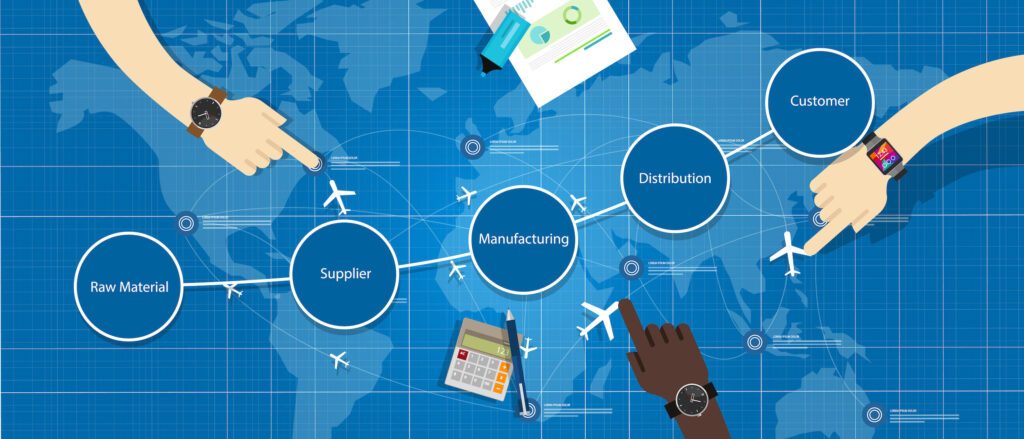The economic front is vast. A myriad of factors, variables, and metrics compiled together might give insight into an economic forecast, but it’s not always that easy. The big picture is complicated. As a customs house broker, we’re on the frontlines of trade, which is only one component of the larger economy and the movement of goods and services. And yet, from where we stand, we get a good view of the supply chain.
And there was a lot of talk about supply chain woes last year and going into 2022. So what might the supply chain look like in the new year and what new challenges may be looming? How will it affect trade— imports and exports?
We look into it.
What is the Supply Chain and What Does it Mean to You?
Let’s begin by defining our terms. What is the global supply chain? In simple terms, the global supply chain is the vast interconnected network and system of exchange of goods, services, and labor that any business uses to produce. In other words, a shoemaker uses the global supply chain to obtain the necessary materials to make their shoe and uses that same supply chain to distribute its goods to market. Sounds easy enough right? Except it isn’t because a well-greased supply chain requires many different elements to be in sync.
The covid 19 pandemic has exposed plenty of vulnerabilities in the system. As Harvard Business Review reported in 2020, the pandemic exposed soft spots in production strategies and supply chains of firms across the globe. The public saw this in shortages of certain goods, bare shelves at the grocery store, the skyrocketing prices of certain materials, shortage of medical supplies, etc.
As the world resets, there is lingering economic and political pressure to ramp up domestic production and fix some of those kinks in the global supply chain that became all too obvious when the world was in complete chaos.
Lessons We Learned from the Exposure of Supply Chain Vulnerabilities
The world has become truly interconnected in its production of many of our most high-tech products. Our demand for electronics and smart technology products has increased, but some of these gadgets and computers require materials that are not only difficult to get but come from various parts of the country. In the second quarter of 2020, for example, global trade was down 18.5%.
Take microcontroller chips, for instance. It’s not often a dinner table topic, but these little computer chips are an integral part of so many of our goods and products. When the supply chain clogged in late 2020 and throughout 2021, access to these materials and to these computer chips had ripple effects across various industries.
We wrote about this in a previous post in July of 2021. So as these chips became scarce, production lines at car manufacturers, appliance factories, and other industrial plants slowed or came to a screeching halt. In the car industry, for example, the semiconductor shortages led to historically low vehicle inventories.
Lessons Learned During Supply Chain Shortages
According to experts that monitor supply chains, we can walk away with several important lessons.
- Planning for unexpected supply chain events is key. Manufacturers and supply chain partners should plan for contingencies and expect challenges to come more than just every blue moon.
- Just-in-time manufacturing may subside. This idea allows companies to improve their bottom line by keeping inventory low and producing the product just as it goes off to market. However, this way of doing things is not sustainable when the chains are questioned.
- Our economy is semiconductor-dependent. In the data-driven and electronics world, this component is essential. Perhaps it’s time to increase domestic production of these ever more in-demand components.
- Improve relationships with suppliers. The relationships between suppliers and manufacturers should be improved to be more dynamic and diversified. Diversifying supply lines gives producers several options.
Are the Supply Chain Woes Here to Stay?
It’s difficult to say and even experts don’t see eye to eye on this matter. That’s because so much has been difficult to predict in the past few years. New variants, labor shortages, and changes in the workforce are all fluid factors that are constantly changing.
Reports in early 2022 suggested that new concerns might impact the supply chains again. This includes reports that China was looking to increase lockdowns because of the new Omicron variant, which would impact imports and exports with China.
Imports coming into the United States need to be guarded from possible problems by carefully monitoring the situation. The backlogs that made headlines a few months ago in the ports of Los Angeles have slowly been cleared and authorities remain vigilant to ensure it doesn’t happen again.
Benefits of Working with a Customs Broker
Working with a customs broker when engaging with the global supply chain means several benefits. A customs broker specializes in imports and exports and helps businesses and producers navigate the supply chain effectively. They understand:
- Custom laws
- Tariff schedules
- Customs classifications
- Trade documentation
- Customs clearance
Questions About the State of Imports and Exports? Work with a Customs Broker
Are you a business or manufacturer looking to engage with the global supply chain? Want to avoid headaches and ensure compliance? Call RM Customhouse today and learn more.


